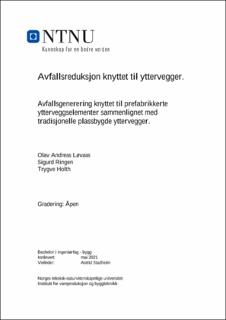| dc.contributor.advisor | Stadheim, Astrid | |
| dc.contributor.advisor | Amdahl, Odd Anders | |
| dc.contributor.author | Løvaas, Olav Andreas | |
| dc.contributor.author | Ringen, Sigurd | |
| dc.contributor.author | Holth, Trygve | |
| dc.date.accessioned | 2021-09-24T19:25:11Z | |
| dc.date.available | 2021-09-24T19:25:11Z | |
| dc.date.issued | 2021 | |
| dc.identifier | no.ntnu:inspera:77257390:81861934 | |
| dc.identifier.uri | https://hdl.handle.net/11250/2782303 | |
| dc.description.abstract | Byggebransjen er globalt sett den største forbrukeren av råmaterialer i dag. Et av de viktigste områdene for å redusere bransjens miljøavtrykk er å redusere avfallet. Det vil være avgjørende at bransjen klarer å implementere en sirkulær økonomisk struktur for å øke materialutnyttelsen. I denne bacheloroppgaven ønsker vi å undersøke forskjellen på avfallsgenerering av prefabrikkerte ytterveggselementer sammenlignet med tradisjonelle plassbygde yttervegger. Videre tar oppgaven for seg hvordan produksjonen av yttervegger kan imøtekomme bransjens økende behov for avfallsreduksjon.
Bacheloroppgaven baseres på litteraturstudie, intervjuer og beregninger for å svare på oppgavens problemstilling. Litteraturstudien som har blitt foretatt er gjort for å innhente relevant fagstoff knyttet til temaet. Det har blitt foretatt intervjuer for å skape en helhetlig forståelse knyttet til oppgavens tema. Beregningene som er gjort illustrerer hvor mye avfall produksjon av yttervegg genererer og sammenligner plassbygde og prefabrikkerte yttervegger.
Resultatene i oppgaven bekrefter at det vil bli en økning av avfall hos produsent ved at byggeplassene tar i bruk prefabrikkerte ytterveggselementer på sine prosjekter. Likevel viste beregninger at avfallsmengden vil reduseres med rundt 45 %, ved å flytte produksjonen av yttervegger fra byggeplass til produsent. Denne reduksjonen tilskrives blant annet bedre kapputstyr, bedre utnyttelse av materiale og innendørs produksjon. Prefabrikkerte ytterveggselementer kan også være viktig dersom byggebransjen i fremtiden skal basere seg ytterligere på materiallagring i bygg. | |
| dc.description.abstract | The construction industry is considered the largest consumer of raw materials on a global basis today. One of the most effective ways to reduce the industries environmental footprint is to reduce the construction waste. It will be crucial for the industry to implement a circular economic structure to increase the material utilization. In this bachelor thesis we wish to examine the differences of construction waste between exterior walls built on construction sites and prefabricated exterior walls from production site. The thesis also addresses how exterior walls can accommodate the industries increasing need for waste reduction.
The bachelor thesis is based on literature study, interviews and calculations to answer the topic of the thesis. The literature study has been done to obtain relevant subject matter tied to the topic. The interviews have been done to make an overall understanding of this thesis. The calculations which are done illustrates how much waste the exterior walls generate, and it compares the walls built on construction sites with the prefabricated exterior walls produces on production site.
The results confirm that the production sites of prefabricated exterior walls will gain an increase amount of construction waste when the construction sites take prefabricated exterior walls in to use. However, it is shown through the calculations that the amount of waste will reduces with about 45 % by moving the production of exterior walls. This reduction is due to better cutting equipment, greater material utilization, indoor production, among other things. Prefabricated exterior walls also has a good potential if the construction industries in the future want to focus more on material storage in buildings. | |
| dc.language | nob | |
| dc.publisher | NTNU | |
| dc.title | Avfallsreduksjon knyttet til yttervegger. | |
| dc.type | Bachelor thesis | |
